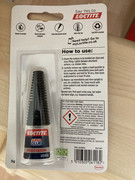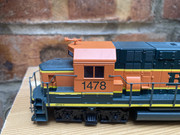Page 1 of 1
Best glue for plastic?
Posted: Sat Aug 05, 2023 11:10 am
by PBoland
Morning folks, a small train horn broke off the roof of a loco. What's the best glue to use for a spot repair. I suppose I'd need to test it first elsewhere?
Thanks in advance.
Re: Best glue for plastic?
Posted: Sat Aug 05, 2023 1:37 pm
by Steve M
Any answer would have to have a caveat that some plastic glues don't work on some plastics.
But as a start I would try an ultra thin glue from Tamiya (try Hobbycraft). Hold the parts together then just touch the brush that comes with the bottle to the joint and it will wick into the joint. Not too much on the brush to avoid it running and ruining the surrounding paintwork.
Re: Best glue for plastic?
Posted: Sun Aug 06, 2023 1:40 am
by Mountain Goat
Oddly, glues I have used in the past that I have considered "Average" can now come with glueing instructions and following these instructions makes a far stronger join (Why is smallprint so small?).
Example, one one glue my Mum bought recently, I had been sceptical for its intended use but tried it by followinginstructions. "Lightly glue both parts and wait four minutes (Think it was four minutes). Then hold pieces together for an instantanious bond." It worked!
One glue from the past I used on my layout and thought it rubish glue was Copydex BUT one day I phoned up a manufacturer of cotton duck bicycle panniers as my old panniers needed repair. (Around 25 years old at the time and had been through some abuse including one being left on a damp floor for a length of time so the bottom rotted out). They said they no longer repaired them because the time it took with todays labour charge is equivalent to a new pair these days, but they did sell a repair kit which had cotton duck that one can cut to patch up ones old panniers,and glue. So I ordered the repair kit which came with Copydex glue! None to pleased I phoned a d was assured that Copydex was the best glue for the job, so I tried it, and do you know that glue is still doing its job today! It is excellent on cotton duck or canvas! Waterproof as well!
With glues, it is about using the right glue for the material. (Copydex is also good for glueingdown track to a board where one may need to lift the track at a future date... But on canvas or cotton duck type materials it really glues these strongly! Hard to try to separate them! No good for card kits and things like that though. Is more of a fabric type glue).
Used to use UHU glue a lot and it works. But itis a strange glue as it hardens as the years go by and dries. When it completely dries in years to come, on some materials it can give up its hold. However other materials it stays strong. I used to like it as it was one of the few glues I used to buy in my mid teens or younger (No laws in those days) that smelled nice as some glues smelt awful when working on ones layout. (Copydex smelt awful and superglue! Accidently get a whif of that and the vapour glues ones eyeballs together! (Or it feels lie that!) And no! I am not into sniffing glue! Not my thing! Just UHU smelt a bit like bananas).
Finally in regards to glues. Bicycle puncture repair kits. Always found older proper rubber patches one cuts to shape to be far superior to modern cheap plasticky patches! Also, if one has ensured the area has been rubbed down with some fine abrasive (Wet and dry or glasspaper) to give the glue something to adhere to, repair kits are two part glues. One part is on the back of the patch. The other is on the glue one uses. I use a ballpoint pen to make repeated crosses where the centre of the cross is the hole. So even after the abrasive has been rubbed, one can guess by the lines outside of the area worked where the tiny hole is. Ballpoint pens can work ok on wet or damp bicycle tubes if one tries using them on ones skin first! When one has applied the glue and gentle smoothed it over the area to be patched, wait a couple of minutes for it to dry. Do not immediately apply the patch to fresh wet glue! Patience! Wait until the glue looks dry and only has a slight damp feel to it. THEN apply the patch. That patch will stick solid! Do it to early and it will not work that well.Don't forget to apply a small amount of chalk powder after one knows the patch is good to prevent any glue sticking the tube to the inside of the tyre! (I know! Sometimes one is in a hurry. I have fixed punctures in a minute or two in the middle of an event, but t is not ideal. Better carry a spare tube and fix the dud one when one has more time, and most important of all, remove the thorn or other culprit from the tyre or one will get another puncture! Some of todays tyres haveno tubes and are like car tyres. Said to be good for low pressure when offroading BUT one needs a good pressure to prevent rim damage so the advantages are pointless. Used to ride tubalars on my time trialling bike, and if one gets a puncture on them one could ride a few miles on that if one is careful not to hit a bump and damage ones rim, as though silk tubalars used to be sent off for repair, ordinary tubalars were binned and replaced. I preferred using tub taps rather than glue. It was less messy and quicker, as the glue had to be left overnight to set. Tub tape was strong. But overall preferred ordinary type clincher rims even on racing bike for overall economy, as punctures in tubalars are expensive, as cost is for a replacement tyre. Silk tubalars and one was always into serious money but few of us bought them. Were £50 per tyre back in the late '80's, where back then ordinary tubilars wefe from £7.95 and up with ordinary tyres from £4.50 and up. Not seen tubilars in bike shops for a few years.
But back to glue. Something I was considering using was strong double sided tape to stick smooth plastic PVC chassis (Had an idea but not tried it yet) to waggon bodies. Glue generally will not like sticking those materials very well but tape will, as have used tape before for other things. Started me off with the idea years ago when I realized just how good car numberplate tape is! Ever tried removing those number plates from trailors or caravans? Wow, strong stuff! But thinner double sided tape needed for waggons. Not sure tape is economical for track though but don't see why it can't be used, as done right and one can stick ballast down as well while one is at it! Wasn't there a product that did that?
Re: Best glue for plastic?
Posted: Sun Aug 06, 2023 11:07 am
by Brian
MG that's a lot of waffle for what the OP needed information on! Bicycle tube repairs - really!

Re: Best glue for plastic?
Posted: Sun Aug 06, 2023 12:54 pm
by IanS
He's got it off his chest now - I even read 75% of it before giving up!
Re: Best glue for plastic?
Posted: Sun Aug 06, 2023 2:13 pm
by PBoland
Many thanks guys and I reckon there is a PhD on glues in there somewhere

Re: Best glue for plastic?
Posted: Mon Aug 07, 2023 12:22 am
by Mountain Goat
Brian wrote: ↑Sun Aug 06, 2023 11:07 am
MG that's a lot of waffle for what the OP needed information on! Bicycle tube repairs - really!

Sorry. My mind was wondering as it unwound.
Re: Best glue for plastic?
Posted: Mon Aug 07, 2023 12:23 am
by Mountain Goat
P.S. Bought some UHU today!

Re: Best glue for plastic?
Posted: Fri Aug 11, 2023 11:05 am
by PBoland
Some feedback - used a spot of Loctite see photos. Tested on the underside first and then one small drop and all good. Thanks for all your inputs.


Re: Best glue for plastic?
Posted: Fri Aug 11, 2023 11:12 am
by Steve M
PBoland wrote: ↑Fri Aug 11, 2023 11:05 am
Some feedback - used a spot of Loctite see photos. Tested on the underside first and then one small drop and all good. Thanks for all your inputs.


Glad it worked for you but a word of caution when using cyano type glues. The fumes it gives off can react with any residue left by fingerprints on the model, causing a fogging of the paintwork.

